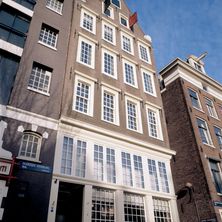

After the Rijksmuseum, Our Lord in the Attic is the second oldest museum in Amsterdam and certainly one of its most remarkable. The unique thing about this Amsterdam monument is that it has a clandestine character. Walking past the church, the passerby is unable to see any trace of it from the outside. The entire church is completely hidden from view behind the facade of a characteristic XVII century canal house. This hidden church 'in the attic' was constructed during the Reformation, when Catholics were forbidden to hold public services.
The history of Our Lord in the Attic began in 1661 when the wealthy merchant Jan Hartman bought a prestigious property on OudezijdsVoorburgwal, known popularly as the Velvet Burgwal.
The property then consisted of a building facing the canal and two houses in the rear. The third floor of the facade house connected in a single extended attic to the upper floors of the two rear houses. The new owner decided to rebuild immediately. On the ground floor and in the basement, Jan Hartman established a shop and storage room. He used the first floor to add a lavish reception room, so as to be able to receive guests and show off his status. This stately drawing room is among the best preserved living-rooms from the Golden Age era and a copy of it has been recreated in Japan.
The church occupies the entire upper floor of the canal house and is accessed by very steep, creaky wooden stairs. The long narrow nave - adorned with fine paintings and sculptures - is lined with two wooden galleries and contains seating for about 150 worshippers.
The church is beautifully decorated in the Dutch classicist style, with marble columns, gilded capitals, and a marble altar with a painting of the Baptism of Christ by Jacob de Wit and stucco sculptures of God the Father and the Holy Spirit. A bonus to this fascinating church is the rest of the private house, which is open to visitors as part of the Museum Amstelkring. It is beautifully preserved in its original XVII century condition.
Our Lord in the Attic is a perfect example of Dutch tolerance. Jan Hartman was a devout Catholic and his son was studying to become a Catholic priest. By then Amsterdam had officially converted to Protestantism and Amsterdam Catholics were prevented from practicing their religion openly. A few years after the Alteration - the Amsterdam conversion to Protestantism in 1578 - the official prohibition on celebrating Catholic mass was imposed. Hartman, thus bent on staying true to his religious choice, decided to convert the top three floors of his house into a clandestine Catholic church. For the next two hundred years, Hartman's attic served as the parish church for all Catholics in the city. The Protestant authorities were aware of the secret church, but turned a blind eye and did not persecute nor try to shut the venue. Amsterdam's policy was to allow the diversity of religious faiths as long as the non-official religions did not flaunt their temples and services to the public.
The house and church underwent some renovations in 1739 after the priest Ludovicus Reiniers purchased the property. He added another stairway, rebuilt the facade and removed the sculpture of a stag outside. The Hart Church was from then on referred to as, "Our Lord in the Attic."
Delve through the narrow passageways, stairways and tiny nooks to uncover splendid works of art, ornate furniture and an atmosphere that will whisk you back in time. The impressive organ, opposite the altar, was designed and built by Hendrik Meyer in 1794 specifically for the church and is still regularly played.
When the imposing St. Nicolas's Church opposite the Central Station became dedicated in 1887, Our Lord in the Attic was at last superseded as the local parish Catholic church. In that same year a group of Amsterdam Catholics pooled their funds and bought this property on the corner of OudezijdsVoorburgwal and HeintjeHoekssteeg, thus saving the Our Lord in the Attic from demolition. A year later on the 28th of April 1888, the church was opened to the public as a museum.